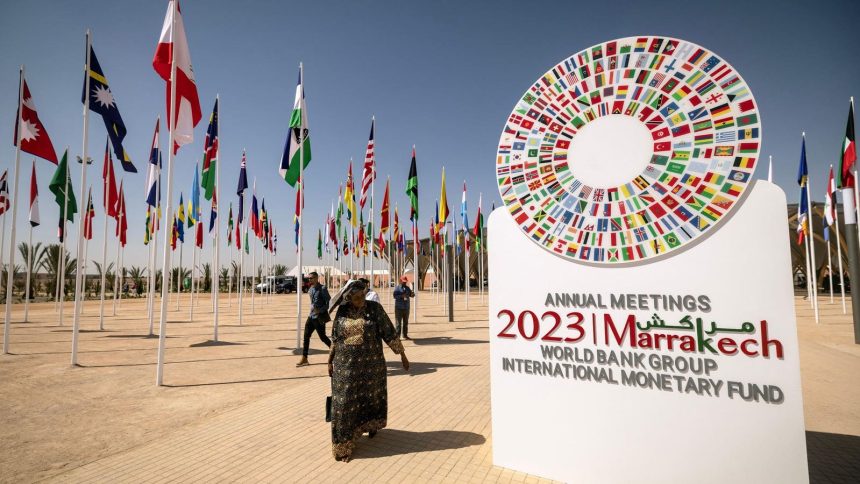This month, Morocco hosted the Annual Meetings of the World Bank and International Monetary Fund, a global gathering of financial heavyweights featuring finance ministers and central bankers from all of the world’s major economies. Foremost on their agenda was charting a collaborative path for the world’s multilateral development banks (MDBs) to adequately fund our planet’s most urgent, global crises, namely climate change, extreme poverty, pandemics, and food insecurity.
MDBs, which are owned by multiple member states, provide financial resources and technical assistance to countries in need. These institutions are often referred to as the “lenders of last resort” because they provide financing to countries that have no other means of borrowing funds for their development needs. Given the MDBs’ crucial role in supporting vulnerable countries in times of crisis, there have been many calls for reforming these institutions in the last few tumultuous years of the global COVID pandemic, increased climate disasters, and growing economic instability. Recognizing that shared global challenges require shared solutions, leaders such as Prime Minister Mia Mottley of Barbados (and her Bridgetown Initiative) have successfully advocated to get MDB reform at the top of the global political agenda.
To her credit, United States Treasury Secretary Janet Yellen took up the mantle and officially kicked off the MDB “evolution” (aka reform) process exactly one year ago at last year’s Annual Meetings. Many incremental steps have since been taken to reform the World Bank and other MDBs, with the objective of making them more fit for purpose to tackle today’s global challenges. For example, the World Bank lowered its equity-to-loan ratio from 20% to 19%, which frees up an additional $5bn per year in new lending capacity, and first the Inter-American Development Bank (IDB), and now the World Bank and the European Investment Bank ( EIB) decided to introduce debt pause clauses in select new loan agreements.
These initiatives have moved the ball forward, but a lot of work remains to be done. To fully meet the needs of today’s world, MDBs still need two things: more money and more cooperation. It is essential that multilateral development banks not only catalyze additional funding to meet growing demand, but also work better together.
More Money
Ahead of the Annual Meetings in Marrakesh last week, momentum for boosting the lending capacity of MDBs was further built through two new reports. The Rockefeller Foundation released an analysis showing that the World Bank, with the right reforms, could lend an additional $190 billion by simply stretching its additional assets. While additive, $190B is insufficient to meet the needs and ultimately new financial contributions from the Bank’s shareholders will be needed, including new paid in capital and more highly concessional, including grant financing for low-income countries that are already in debt distress. On this point, the Open Society Barometer recently released polling showing that particularly in global south countries, support is high for high-income wealthy countries to contribute more to institutions like the World Bank.
According to the United Nations, the world needs trillions, not billions, of new dollars to truly tackle extreme poverty and put countries on the path to achieving sustainable development. MDB shareholders must accept that reforms will have to be combined with increased capital if global financial institutions are to meet the recommended target of tripling their investments in order to contribute their estimated $390B/year share of financing needs.
[INSERT GRAPHIC]
More Cooperation
In this poly-crisis era, where several catastrophic events are coinciding, it is simply not possible for any one institution or nation to take on the burden alone or for financing alone to solve the problems. Greater collaboration between development banks is essential because it will maximize efficiencies, allowing for financing at scale while bringing down transaction costs for borrowers and limiting risks through the diversification of portfolios, which in turn should enhance overall financing capacity and reassure credit rating agencies.
In Marrakech, the heads of major MDBs released a statement committing to “increase the speed and agility” of their operations and to improve the way they work together to maximize their system-wide impacts. Here’s how they can do so.
For starters, MDBs should work to streamline and simplify their processes. World Bank President Ajay Banga himself recently lamented that it takes over two years for projects to commence and often more than ten years before initial project benefits and impacts are felt. For communities struggling with extreme poverty, that is far too long to wait. Drastically reducing project set-up and start-up times would go a long way towards delivering results faster. Banga himself stated: “Development delayed is development denied.” His aim to reduce WB project review and approval times by ⅓ is a laudable goal that other MDBs with lengthy start up times should also consider. One MDBs that has made progress in the area of streamlining is the Asian Infrastructure Investment Bank (AIIB) (Disclaimer: AIIB has partnered with the organization I work for, Global Citizen). Specifically, the AIIB has started streamlining its application processes in order to greatly reduce the administrative burden on borrowing countries. The aim is to allow borrower countries to use one set of documents to tap necessary funding streams with the AIIB and other MDBs, saving valuable time and money. We applaud the MDB heads’ recent commitment to “harmonizing and mutually recognizing each other’s policies and standards” and encourage swift implementation of these changes.
Another area of opportunity where experts agree MDBs should focus is on improving their ways of working better together to ensure they operate more as a system versus disparate, disjointed entities. This could include more active and expanded use of guarantees and portfolio swaps to improve average credit ratings and allow for more exposure for lower-rated members. Pooling risks and increasing co-financing of projects are additional ways to strengthen collaboration. One manifestation of this cross-bank collaboration is the AIIB-World Bank initiative to issue USD$1 billion in credit guarantees against sovereign-backed loans, which significantly strengthened both MDBs’ collective financing capacity. Creating the space to have more regular dialogues on common goals and challenges would strengthen institutional collaboration for the benefit of client countries.
A specific area where MDBs need to make more progress jointly on is climate financing: they all expand financing for climate mitigation and adaptation, but more is needed, also through joint work, including: fully pulling out of fossil fuel financing, direct and indirect, to align with the Paris agreement, further refining their methodology on what counts as climate finance, and timely and comprehensive reporting of the funding streams. This also is also part of their recent Marrakesh commitments . Given the criticism in the past around the opacity of climate finance and the work still needed for MDBs to fully align with the Paris agreement from 2015, any additional progress ahead of COP28 would send a positive signal, especially as it is unclear whether the $100bn climate finance promise from Copenhagen will finally be met this year and many governments of wealthy nations haven’t been more transparent.
By increasing their collaboration, MDBs have a profound opportunity to amplify their collective capability to deploy finances and impact the many, growing needs low-income countries face. Global challenges cannot be solved in isolation. By establishing common platforms that leverage resources and expertise, mitigate risks, and provide coordinated support, financial institutions can more effectively tackle the biggest challenges of the 21st century.
Read the full article here










